To American car enthusiasts who love revered cars like the Nissan Skyline R34 and Land Rover Defender, the infamous 25-year import rule is the ultimate challenge. Yet while Skylines and Defenders were restricted under the watchful eye of the feds, the first-generation Smart Fortwo (1998-2007) is able to drive down our roads without fear of becoming a block of crushed metal and plastic. Here’s why.
First, what is the so-called 25-year import rule? The Imported Vehicle Safety Compliance Act was signed into law in 1988, essentially banning the import of any foreign vehicle not intended for the American market unless it’s at least 25 years old. On the surface, the law exists to keep unsafe vehicles off American roadways. But really it seems to serve only the interests of automakers.
There are two ways to deal with the 25-year rule. You could sneak around, flouting the law, only to see your beautiful car meet the business end of a crusher. Or you could have a Registered Importer modify and certify the car to meet American safety regulations.
When the first-generation Smart Fortwo (originally named the Smart City Coupe) entered the market in 1998 to strong European sales and huge public interest, the United States missed out. While Smart was still considering entering the United States market with an SUV (a story all its own), some individuals and companies began to take matters into their own hands by importing this forbidden fruit. There was one problem: These cars did not comply with Federal Motor Vehicle Safety Standards issued by NHTSA.
The agency has this to say about importing vehicles that do not meet FMVSS:
A vehicle that was not originally manufactured to conform to all applicable FMVSS cannot be lawfully imported into the U.S. unless it is first determined by NHTSA to be eligible for importation. The agency makes these decisions on the basis of petitions from [Registered Importers]. These are business entities that are specifically approved by NHTSA to import nonconforming vehicles and to perform the necessary modifications on those vehicles so that they conform to all applicable FMVSS. The petitions must specify that the vehicle is substantially similar to a U.S.-certified vehicle, or that the vehicle has safety features that comply with, or are capable of being altered to comply with, the FMVSS based on destructive test information or other evidence the agency deems adequate.
If you want to import a noncompliant vehicle, you normally have to petition NHTSA for Import Eligibility. However, it’s not as easy as emailing a form to NHTSA stating that you want to import your new Renault Avantime. No, you either have to be a federally licensed Registered Importer or persuade a Registered Importer to handle things for you.
The Registered Importer submits a petition to NHTSA, which decides whether the given vehicle is eligible for importation. Buried in the legalese is the provision that the Registered Importer must also argue that certain parts of the vehicle already meet regulations and that other parts could be modified to do so.
G&K Automotive Conversion of Santa Ana, California, and J.K. Technologies of Baltimore, Maryland, took on the challenge of importing Smart Fortwos in 2003. J.K. Technologies attempted to import Nissan Skyline R34s as well. A potentially easier workaround than making modifications for importation would be if there is a substantially similar vehicle already conforming to FMVSS in the United States. Sadly, the Smart Fortwo and Nissan Skyline did not meet this requirement.
After receipt of the petition, NHTSA reviews it and makes a decision on whether the vehicle can be imported, and if it can, what needs to be done to make it legal. For the Smart Fortwo, the decision was effective January 1st, 2004, less than a year after G&K Automotive and J.K. Technologies submitted their petitions. The end result of those petitions was that 2002-4 Smart Fortwo cars were eligible for importation, as G&K Automotive and J.T. Technologies demonstrated that the cars can be modified to comply with FMVSS standards.
What are some of the things that G&K had to do to make my little Smart compliant? You can read the lengthy NHTSA decision (which lists much of the actual changes as confidential) or you can look right here, as I have a whole fleet of four Smarts, including one European import.
The most obvious change compared with the European model is swapping the factory halogen headlight reflector housings for projector lights that meet regulations. They’re the peanut-shaped lights on the dark red car below.
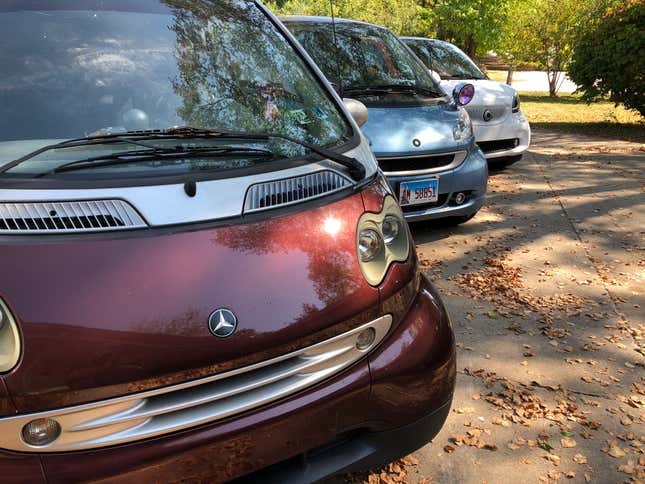
On the side of the car you’ll also find amber and red marker lights with reflectors that appear almost tacked on.
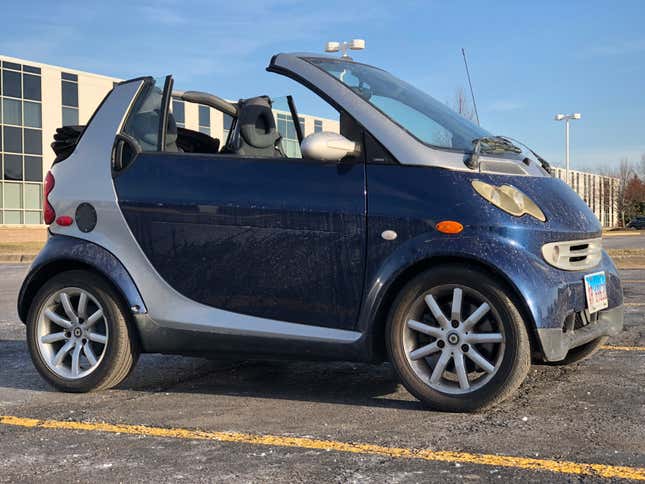
Inside, the speedometer has been converted to read in miles per hour, and the odometer is set to read miles. The gear indicator has a little sticker that attempts to recreate which gear is where on the gear lever. A for Automatic, N for Neutral, and R for reverse.
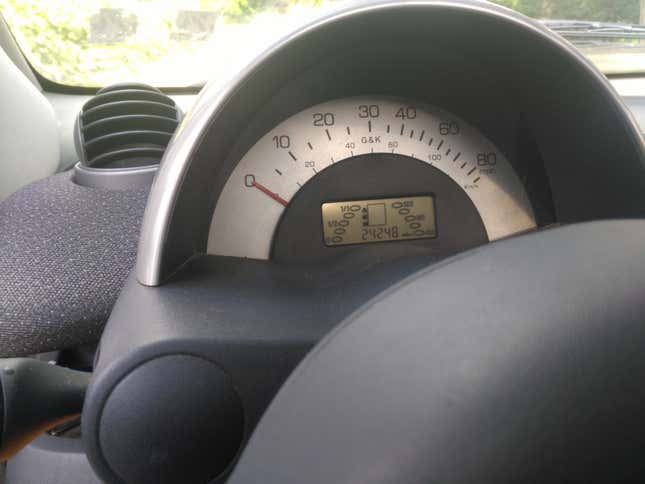
If that “ANR” shift pattern seems weird, that’s because it is!
The transmission these cars came with were available in two software versions. The standard version of the software forced the driver to move the knob forward to upshift, backward to downshift.
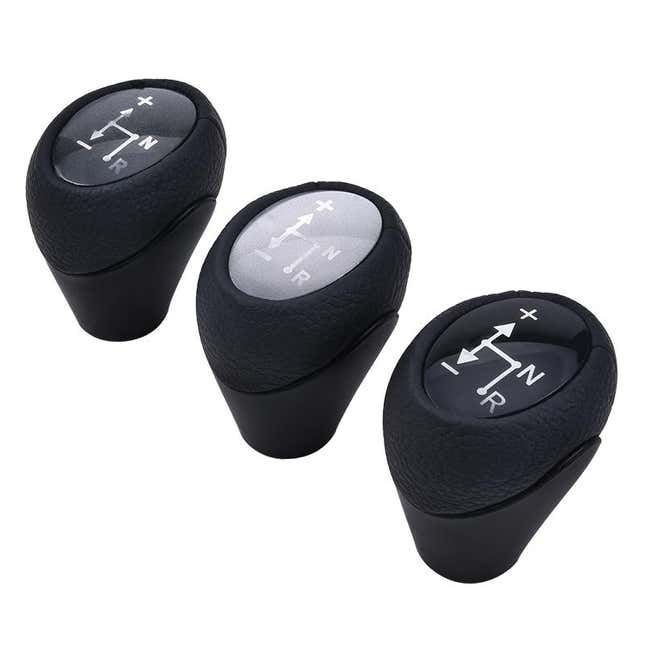
The optional software added the capability for the computer to do all shifting. This was achieved through a physical button on the side of the shift knob.
Inside the cabin you’ll find heavy padding on the A-pillar and roof rails. The interior was also treated in an effort to make it less flammable.
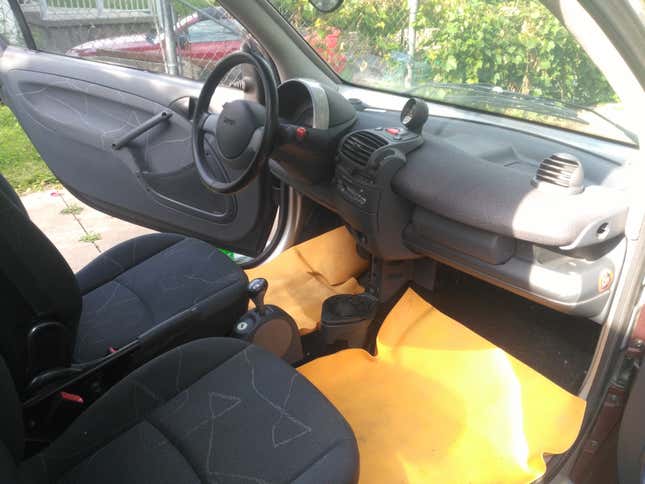
Roof failures were unfortunately a problem with these first-generation cars, potentially due to impact damage. The fix from Smart was a plastic film along the front of the roof. This same fix was applied to converted Smarts. This is apparently enough to bring the end of the exploding roofs. Mine holds up well!
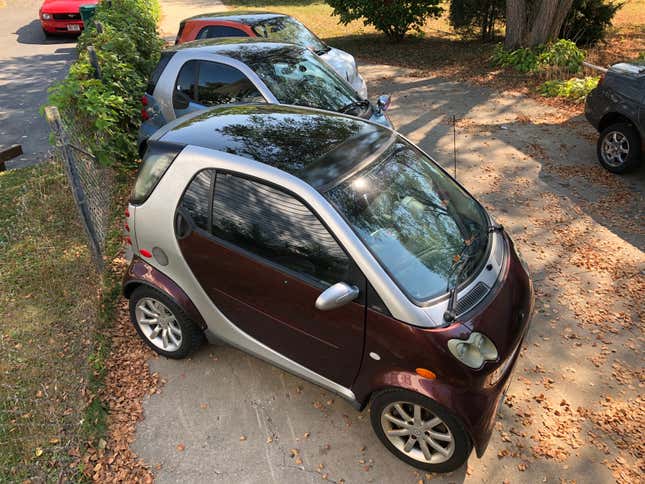
Most of the other changes are under the skin and involve safety improvements like seat anchors. And of course there are emissions system upgrades to be done, but that’s to meet a separate set of EPA regulations, not as part of the 25-year rule.
No public crash test data appears to exist for converted Smarts, however the unmodified cars hold a three-star rating under the Euro NCAP. Keep in mind that a three-star-rated vehicle from two decades ago may not be as safe as a current-three star vehicle.
On NHTSA’s Import and Certification FAQs page with the Smart Fortwo, it’s noted that while Skyline 1990-99 GTS and GTR models were also on the petition and initially granted, NHTSA rescinded the grant of eligibility for R34 Skylines, finding the modifications petitioned by J.K. Technologies were not sufficient to conform.
So you might ask, why couldn’t a Registered Importer petition again with modifications that will work?
A Registered Importer could petition Skyline R34 again, however the R34 is a particular case that makes any subsequent attempt even harder. It’s even detailed on NHTSA’s FAQ page. When NHTSA denied J.K. Technologies’ petition to grant eligibility to import the Nissan Skyline R34, it also granted the company confidentiality in regard to the modifications made in its attempt to conform to standards. This could explain why the Nissan Skyline R34 continues to be banned while I’m allowed to drive around the country in a Smart Fortwo. But honestly that’s just the tip of the iceberg as far as various companies trying to slip pastthe 25-year rule.
J.K. Technologies was the importer for the three Skylines involved in the incredible Rivsu drama and did the heavy lifting of certification for Motorex, the biggest scandal in JDM imports this country has ever seen. It involved attempted kidnapping charges at one point, as 0-60 Magazine’s investigation detailed. The madness of Skylines being imported and subsequently crushed is so intriguing it’s probably worthy of a Hollywood dramatization. Importers who take the chance through various sketchy methods often face very predictable and saddening results.
Yet, the Smart Fortwo sailed through the approval process without drama. I guess so few people care about these cars they’re not even worth kidnapping someone over. I know of a number of Smart Crossblades, Smart Roadsters and diesel Fortwos imported successfully.
G&K still offers its services to import and convert cars. Ultimately, these cars were the first taste of Smart ownership for many, years before the official debut of the second-generation Smart Fortwo in the United States in 2008. The Smart Fortwo is on the list of a surprising number of cars eligible for importation while many other desirable cars remain blocked.
It’s funny to think that the first Smart that Americans were supposed to get was a SUV, but that’ll be a fun story for another day!